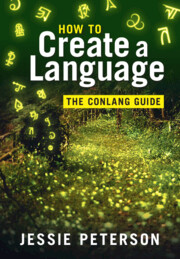Refine search
Actions for selected content:
33 results
13 - Typological Reorientation in the History of English
- from Part II - Contact and External Influences
-
-
- Book:
- The New Cambridge History of the English Language
- Published online:
- 30 October 2025
- Print publication:
- 30 October 2025, pp 356-384
-
- Chapter
- Export citation
15 - Historical Morphology
- from Part III - The Long View by Levels and Areas
-
-
- Book:
- The New Cambridge History of the English Language
- Published online:
- 30 October 2025
- Print publication:
- 30 October 2025, pp 468-544
-
- Chapter
- Export citation

How to Create a Language
- The Conlang Guide
-
- Published online:
- 23 October 2025
- Print publication:
- 02 October 2025
-
- Textbook
- Export citation
10 - Reflections on How Words Bear Meaning, and What This Implies for Complex Words
- from Part II - Semantic Questions
-
- Book:
- Reflections on English Word-Formation
- Published online:
- 03 October 2025
- Print publication:
- 07 August 2025, pp 77-89
-
- Chapter
- Export citation
27 - Reflections on Inflection inside Word-Formation
- from Part VII - Questions Involving Inflection
-
- Book:
- Reflections on English Word-Formation
- Published online:
- 03 October 2025
- Print publication:
- 07 August 2025, pp 209-217
-
- Chapter
- Export citation
2 - Reflections on the Background to the Study of Word-Formation
- from Part I - Basic Questions
-
- Book:
- Reflections on English Word-Formation
- Published online:
- 03 October 2025
- Print publication:
- 07 August 2025, pp 13-34
-
- Chapter
- Export citation
28 - Reflections on Canonical Form
- from Part VII - Questions Involving Inflection
-
- Book:
- Reflections on English Word-Formation
- Published online:
- 03 October 2025
- Print publication:
- 07 August 2025, pp 218-224
-
- Chapter
- Export citation
29 - Reflections on the Spread of Regular Inflection to Simple and Derived Forms
- from Part VII - Questions Involving Inflection
-
- Book:
- Reflections on English Word-Formation
- Published online:
- 03 October 2025
- Print publication:
- 07 August 2025, pp 225-231
-
- Chapter
- Export citation
6 - Morphology and Morphosyntax: The Fate of Inflection and the Formation of Paradigms
-
- Book:
- The Balkan Languages
- Published online:
- 31 May 2025
- Print publication:
- 26 June 2025, pp 495-780
-
- Chapter
-
- You have access
- Open access
- HTML
- Export citation
4 - Construction Morphology and Relational Morphology
- from Part I - The Constructional View of Language
-
-
- Book:
- The Cambridge Handbook of Construction Grammar
- Published online:
- 30 January 2025
- Print publication:
- 06 February 2025, pp 101-128
-
- Chapter
- Export citation
7 - The Prosodic Word
- from Part II - The Higher Prosodic Constituents: Prosodic Words, Prosodic Phrases and Intonation Phrases
-
- Book:
- German Phonology
- Published online:
- 04 January 2025
- Print publication:
- 09 January 2025, pp 271-356
-
- Chapter
- Export citation
22 - Morphosyntactic Reflexes of Information Structure
- from Part 3 - Syntax
-
-
- Book:
- The Cambridge Handbook of Slavic Linguistics
- Published online:
- 16 May 2024
- Print publication:
- 23 May 2024, pp 477-498
-
- Chapter
- Export citation
7 - Inflectional Endings: Declensions
- from Part 2 - Inflectional and Derivational Morphology
-
-
- Book:
- The Cambridge Handbook of Slavic Linguistics
- Published online:
- 16 May 2024
- Print publication:
- 23 May 2024, pp 129-160
-
- Chapter
- Export citation
9 - Tense and Mood Forms
- from Part 2 - Inflectional and Derivational Morphology
-
-
- Book:
- The Cambridge Handbook of Slavic Linguistics
- Published online:
- 16 May 2024
- Print publication:
- 23 May 2024, pp 179-210
-
- Chapter
- Export citation
21 - Voice
- from Part 3 - Syntax
-
-
- Book:
- The Cambridge Handbook of Slavic Linguistics
- Published online:
- 16 May 2024
- Print publication:
- 23 May 2024, pp 447-476
-
- Chapter
- Export citation
6 - The Organization of the Mental Grammar
- from III - The Mental Grammar, Language Universals, and Language Change
-
- Book:
- A Mind for Language
- Published online:
- 13 October 2023
- Print publication:
- 21 September 2023, pp 153-203
-
- Chapter
- Export citation
Gender marking in the first-person singular: A case of paradigm (in)consistency
-
- Journal:
- Journal of Linguistics / Volume 60 / Issue 3 / August 2024
- Published online by Cambridge University Press:
- 06 September 2023, pp. 527-561
- Print publication:
- August 2024
-
- Article
-
- You have access
- Open access
- HTML
- Export citation
8 - Morphology in RRG
- from Part Two - Topics in RRG: Simple Sentences
-
-
- Book:
- The Cambridge Handbook of Role and Reference Grammar
- Published online:
- 08 June 2023
- Print publication:
- 22 June 2023, pp 368-402
-
- Chapter
- Export citation
7 - Derivational and Inflectional Affixes in Chinese and Their Morphosyntactic Properties
- from Part Two - Morpho-lexical Issues in Chinese
-
-
- Book:
- The Cambridge Handbook of Chinese Linguistics
- Published online:
- 04 August 2022
- Print publication:
- 18 August 2022, pp 135-157
-
- Chapter
- Export citation
3 - Morphological Constructions
-
- Book:
- Construction Grammar
- Published online:
- 20 September 2023
- Print publication:
- 28 July 2022, pp 48-102
-
- Chapter
- Export citation
